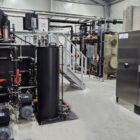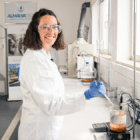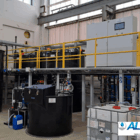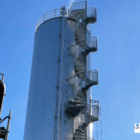Table of contents
Basics of redox measurement
Electrochemical background
The redox potential indicates the extent to which a substance can release (oxidize) or accept (reduce) electrons. It is measured in millivolts (mV) and is directly related to the concentration of oxidized and reduced species in the solution. The redox measurement is based on the Nernst equation, which describes the redox potential as a function of the standard potential and the concentration ratios of the redox pairs.
The measured potential is an indicator of the electrochemical equilibrium between oxidizing (e.g. oxygen, chlorine) and reducing substances (e.g. hydrogen sulphide, iron(II)).
Measurement methods and optimization in practice
Online redox measurement
In modern plants, online redox measuring systems are used that continuously record values and transmit them to process control systems (e.g. SCADA or DCS). Advantages of these systems:
- Real-time monitoring and automatic process adjustment.
- Alarm function for deviations from the setpoint.
- Data recording for analysis and optimization.
Calibration and maintenance
For precise measurements, redox electrodes must be calibrated and cleaned regularly, as deposits (e.g. from flocculants or organic substances) can impair sensitivity. Calibration solutions with known redox values (e.g. quinhydrone buffer) are used to check the accuracy of the electrode.
Technical components of redox measurement
Structure of a redox electrode
The redox measurement is carried out using a pair of electrodes consisting of:
- Measuring electrode: Usually made of platinum or gold, as these materials are chemically inert and have a high electrical conductivity. The measuring electrode interacts with the redox pairs in the solution and develops a potential that is proportional to the redox status.
- Reference electrode: Typically a silver/silver chloride (Ag/AgCl) or calomel electrode that provides a stable comparison potential.
- Measuring device: Converts the differential potential between the measuring electrode and the reference electrode into a readable value.
Functionality
The measuring principle is based on the fact that an electrochemical equilibrium is established between oxidized and reduced species on the surface of the measuring electrode. The resulting electrical voltage is measured and displayed as a redox potential.
Practical significance of redox measurement in water and wastewater technology
1. disinfection
In water treatment, the redox potential is often used to monitor disinfection, especially when using chlorine, ozone or hydrogen peroxide. A high redox potential (e.g. > 650 mV) indicates sufficient oxidizing power, which is necessary to kill germs and pathogens.
- Example of chlorine:
When using chlorine, the redox potential is an indicator of the disinfection performance. Chlorine oxidizes organic compounds and microorganisms, which increases the redox potential.
2. oxidation of pollutants
The redox potential is used in the Fenton reaction, in which iron(II) salts and hydrogen peroxide react to produce hydroxyl radicals (OH-). These radicals oxidize organic pollutants very efficiently.
- Typical target: Degradation of organic substances that are difficult to break down (e.g. in pharmaceutical or chemical wastewater).
3. precipitation and reduction of chromium(VI) to chromium(III) with sodium bisulfite
The reduction of chromium(VI) to chromium(III) in industrial waste water is a special field of application for redox voltage. Chromium(VI) is a highly toxic and carcinogenic heavy metal that occurs in many processes, for example in metal processing or surface treatment. In order to comply with legal limits, chromium(VI) is often reduced by sodium bisulphite (NaHSO₃).
Reaction mechanism:
Sodium bisulphite acts as a reducing agent that converts chromium(VI) in an acidic solution into the less toxic and more easily precipitated form chromium(III).
- Chromate ions (Cr₂O₇²-) are converted into chromium(III) ions (Cr³⁺) by electron transfer.
- Protons (H⁺) from the acidic solution support the reduction.
- The resulting chromium(III) can then be removed from the water by precipitation as chromium hydroxide (Cr(OH)₃).
Redox potential monitoring:
The redox potential is a key parameter in this process, as it reflects the effectiveness of the reduction:
- Ein niedriges Redoxpotential (< +200 mV) zeigt an, dass genügend Reduktionsmittel vorhanden ist und die Reaktion in Richtung Chrom(III) verläuft.
- Rising redox values indicate that the reduction is incomplete or that additional dosing of sodium bisulphite is required.
Practical implementation:
In practice, sodium bisulphite is dosed in an oxygen-free, highly acidic environment (pH 2-3) to ensure efficient and complete reduction. The resulting chromium(III) is precipitated as insoluble chromium hydroxide by raising the pH to 7-9 and can be removed by sedimentation or filtration.
This process combines chemical dosing, redox potential monitoring and precipitation processes and ensures safe and compliant wastewater treatment.
4. biological wastewater treatment
The redox potential is an important parameter in biological wastewater treatment as it reflects the activity of microorganisms:
- Aerobic processes: High redox values (> 200 mV).
- Anaerobe Prozesse: Niedrige Redoxwerte (< -200 mV).
Targeted monitoring of the redox voltage helps to optimize the processes and protect the system from undesirable biological reactions (e.g. sulphate reduction or methane formation).

Photo: Our CP system ALMA CHEM MCW with sodium bisulphite dosing for the reduction of chromium VI
Factors influencing the redox voltage
Concentration of redox pairs
A change in the concentration of the oxidized or reduced species leads to a shift in the redox potential. An increase in the concentration of the oxidizing agent (e.g. ozone) increases the value.
pH value
As many redox reactions depend on protons (H⁺), the pH value influences the redox potential. For example, an alkaline medium shifts the oxidation reactions of oxygen.
Temperature
As the temperature rises, the kinetic energy of the molecules increases, which increases the reaction rate and thus the redox potential.
Presence of impurities
Dissolved organic substances or salts can influence the redox reactions either by being oxidized/reduced themselves or by triggering side reactions.
Measurement and control in practice
In industrial plants, the redox voltage is often measured online using robust electrodes that are integrated directly into the process streams. The measured values serve as the basis for the automated control of chemical dosing and processes. Examples
- Dosing of oxidizing agents: Optimum addition of chlorine or ozone for disinfection.
- Monitoring of anaerobic reactors: Ensuring stable process conditions by monitoring the redox level.
- Corrosion protection in cooling circuits: Avoidance of corrosive conditions by controlling the redox voltage.
Conclusion
ORP measurement is an important instrument in water and wastewater treatment as it provides reliable information about the oxidation and reduction processes in a system. Whether for monitoring disinfection processes, controlling heavy metal reductions or optimizing biological reactors - the precise recording and control of the redox potential is crucial for the efficiency and reliability of modern systems. A sound understanding of redox measurement and its influencing factors enables operators and engineers to design stable processes that conserve resources.
For further information on our products, please feel free to contact us at any time!








